MDHearing VOLT Review
We tested MDHearing’s VOLT, a simple, behind-the-ear model designed for mild to moderate hearing loss.
SeniorLiving.org is supported by commissions from providers listed on our site. Read our Editorial Guidelines
MDHearing is a well-established manufacturer of over-the-counter (OTC) hearing aids. The brand even ranks on our list of the best hearing aids. VOLT is one of their behind-the-ear (BTE) hearing aids that is rechargeable and relatively affordable. Like all OTC hearing aids, VOLT is designed for mild to moderate hearing loss.
MDHearing sent me a complimentary pair to try out. In my time at SeniorLiving.org, I’ve tested several hearing aids, including MDHearing’s NEO XS model, so I was excited to try out the VOLT and see how they compare.
In this review I’ll discuss everything about VOLT from soup to nuts. Read on to learn all about these hearing aids, my experience with them, and how they compare to other brands.
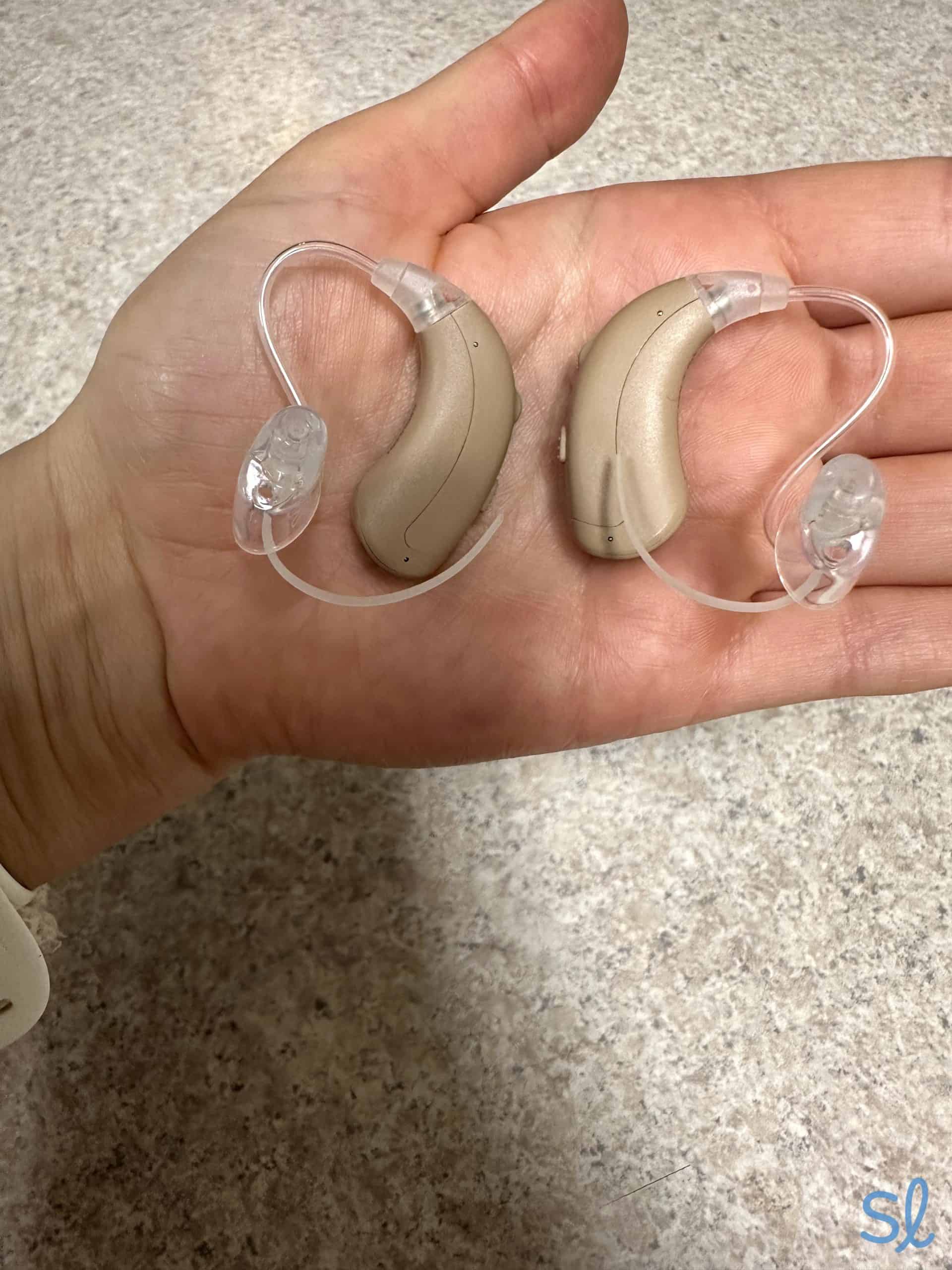
Testing out MDHearing's VOLT devices
Pros
- Free online hearing test
- Available in pairs or as single hearing aids
- Easy-to-understand manual
- Comfortable to wear
- Easily programmable
- 45-day risk-free trial
Cons
- Left/right hearing aids not differentiated well
- No companion mobile app
- Generates mild “white noise” sound
- Volume dial hard to control on the go
- Only available in beige
MDHearing Hearing Test
Before using the VOLT, I took MDHearing’s online hearing test. It was very simple to use. And it took less than five minutes. To get accurate results, you have to be in a quiet place. You also need good quality headphones. My results were similar to those I received in an audiologist’s office.
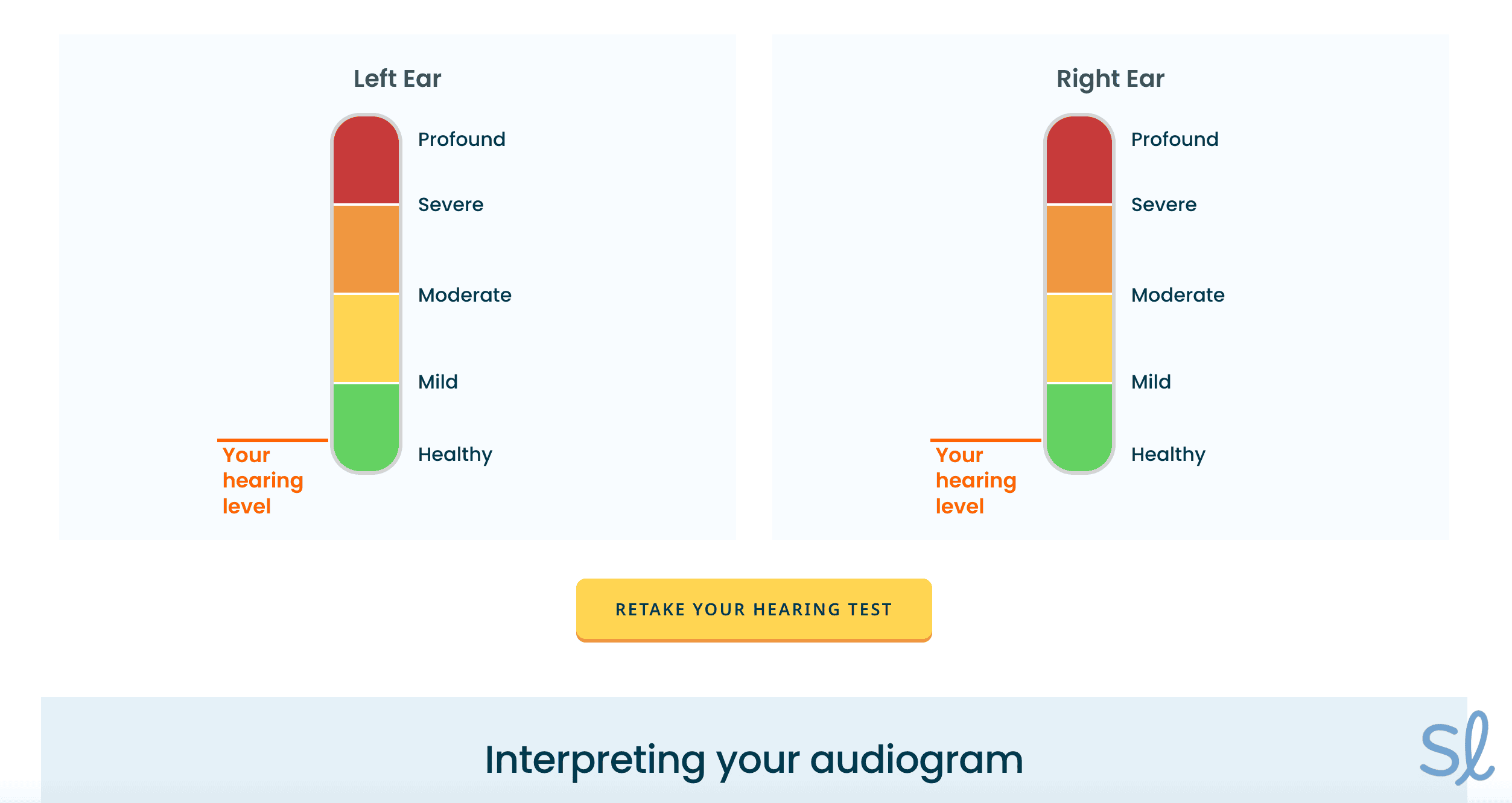
I took MDHearing's online hearing test, which provided clear and simple results.
During the test, six sounds are played in each ear along low, middle, and high frequencies. The isolated frequencies help to identify the frequencies you’re having trouble hearing. This information is pivotal in determining what hearing aid will be best for you. Your easy-to-read results will be available in a thermometer format, as shown above, and as an audiogram:
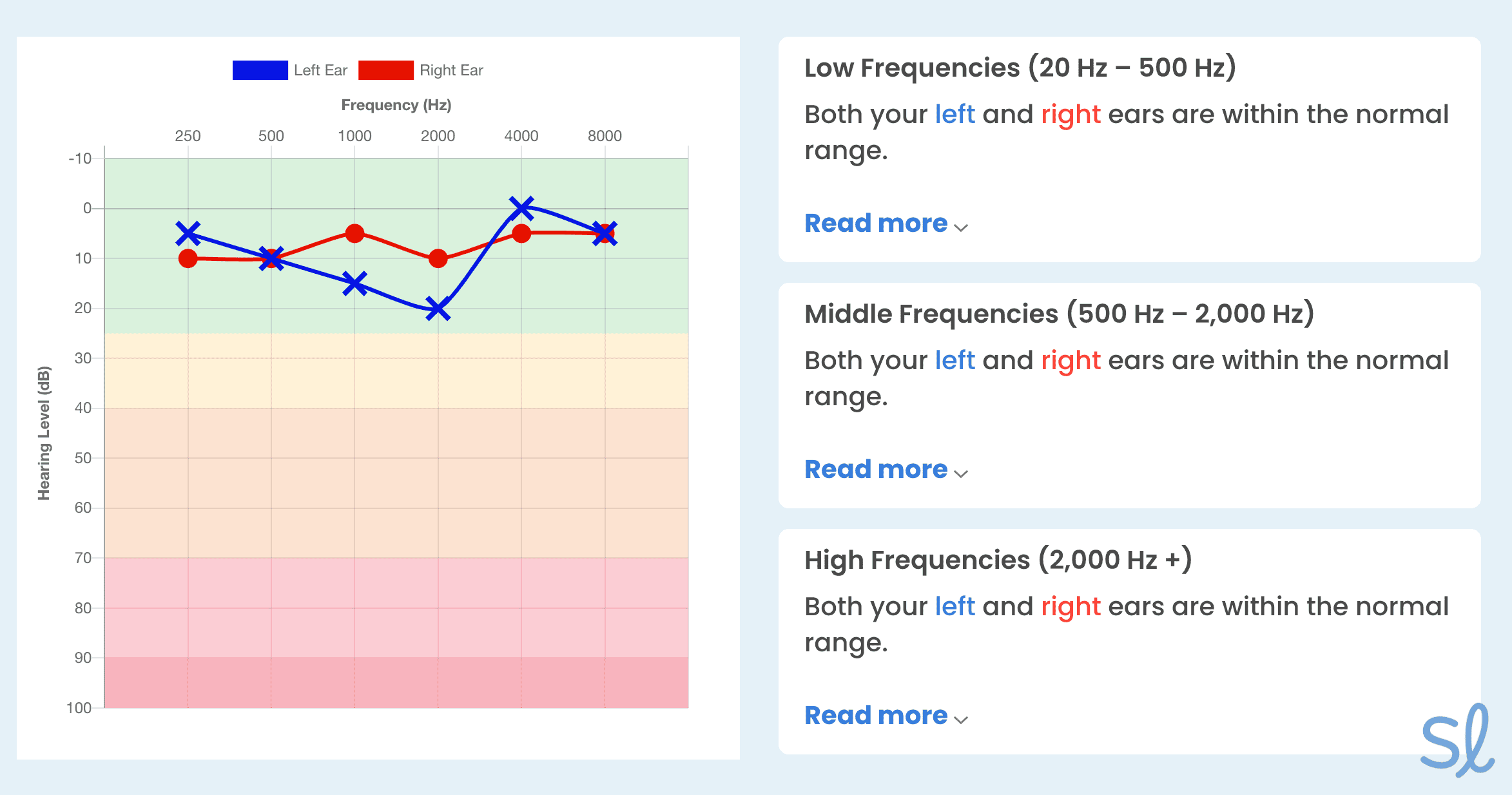
Viewing my hearing test audiogram
Unboxing my VOLT Hearing Aids
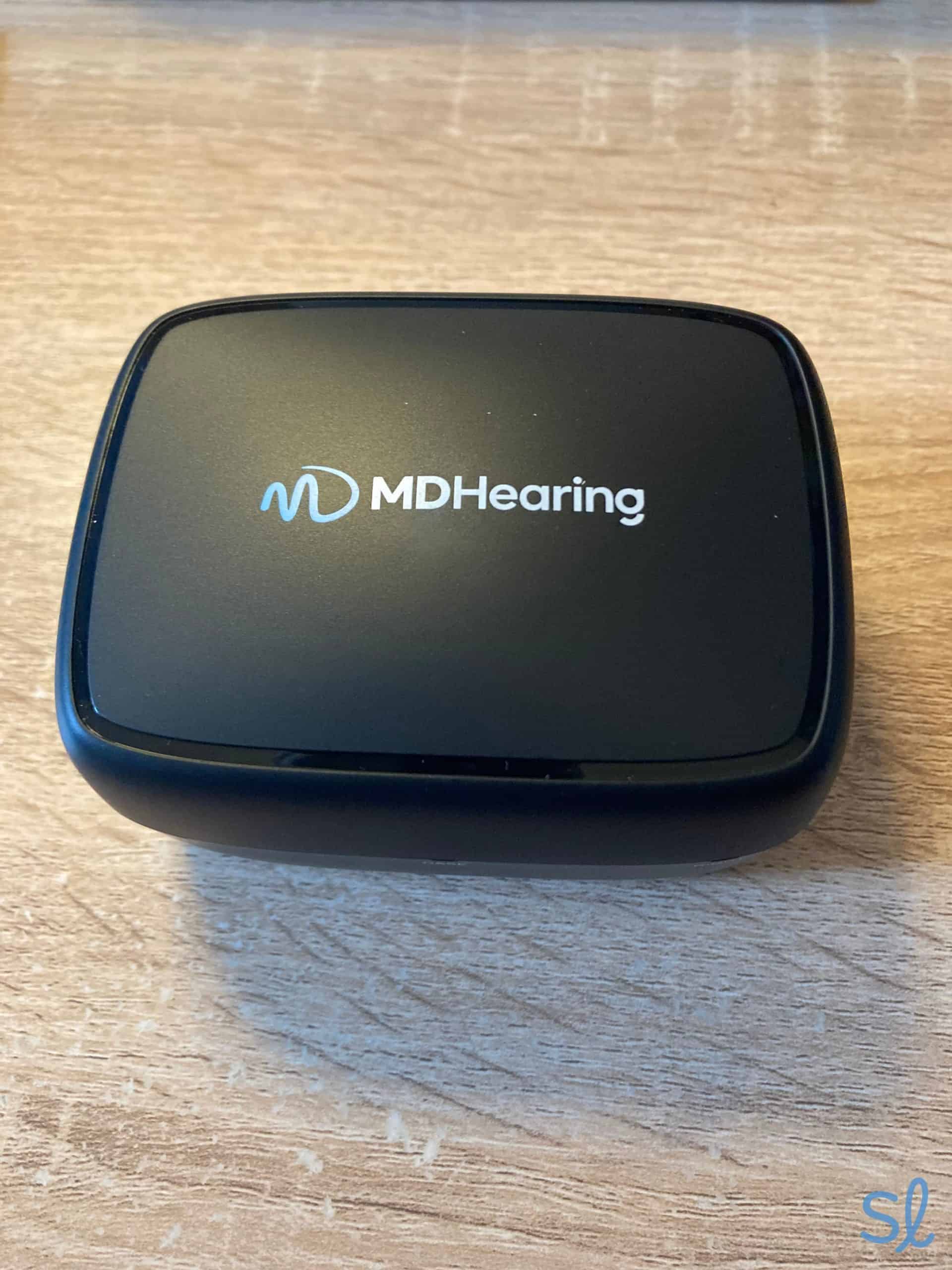
Unboxing my VOLT Hearing Aids
The hearing aids, instruction materials, and accessories were neatly boxed. Everything was clearly labeled. Here’s what was included in the package:
- Hearing aids
- Charging case
- Charger cord and plug
- Read Me First booklet
- Front/back “Charging Your Hearing Aids”/“Cleaning Tool” card
- Tips and tubing calendar reminder card
- User manual
- Cleaning tool
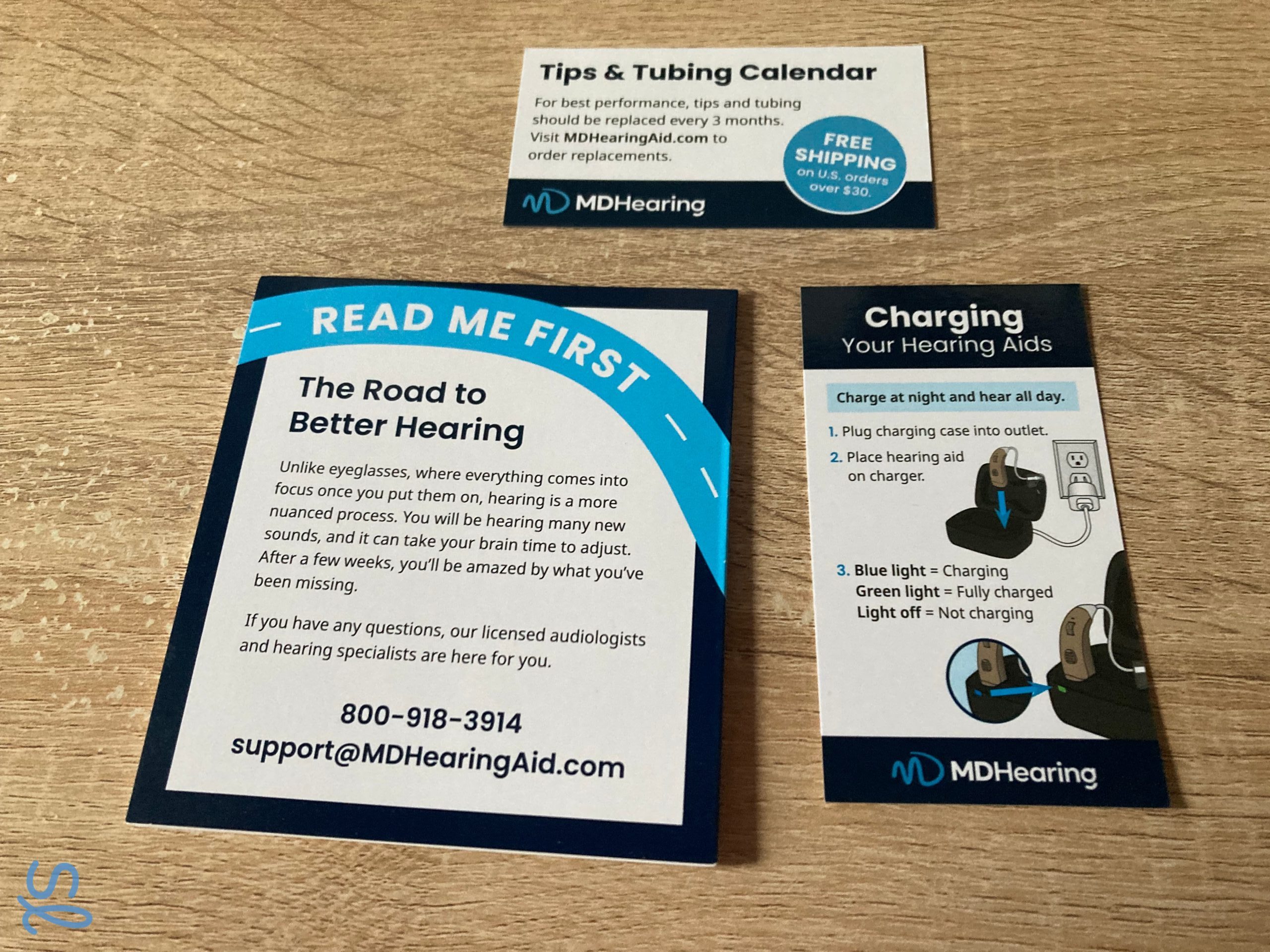
MD Hearing tip cards and instruction manual
I reviewed the tip cards and instruction manual, which were clear and easy to read. The Read Me First card gave a concise breakdown on what to expect during the first three weeks of hearing aid use. I think this is very important information for new users! Many people give up on their hearing aids without giving them a chance, thus prolonging their hearing loss issues. This type of information helps to eliminate that option.
Did You Know? Only 1 in 10 people who need hearing aids use
When I unpacked my hearing aids, I noticed what seemed to be excess tubing on the stabilizer bar. The manual referenced this. It indicated that I could clip the ends off if I chose to, in order to fit the size of my ears. I decided not to cut them, as the tubing didn’t show once I had the hearing aids in my ears.
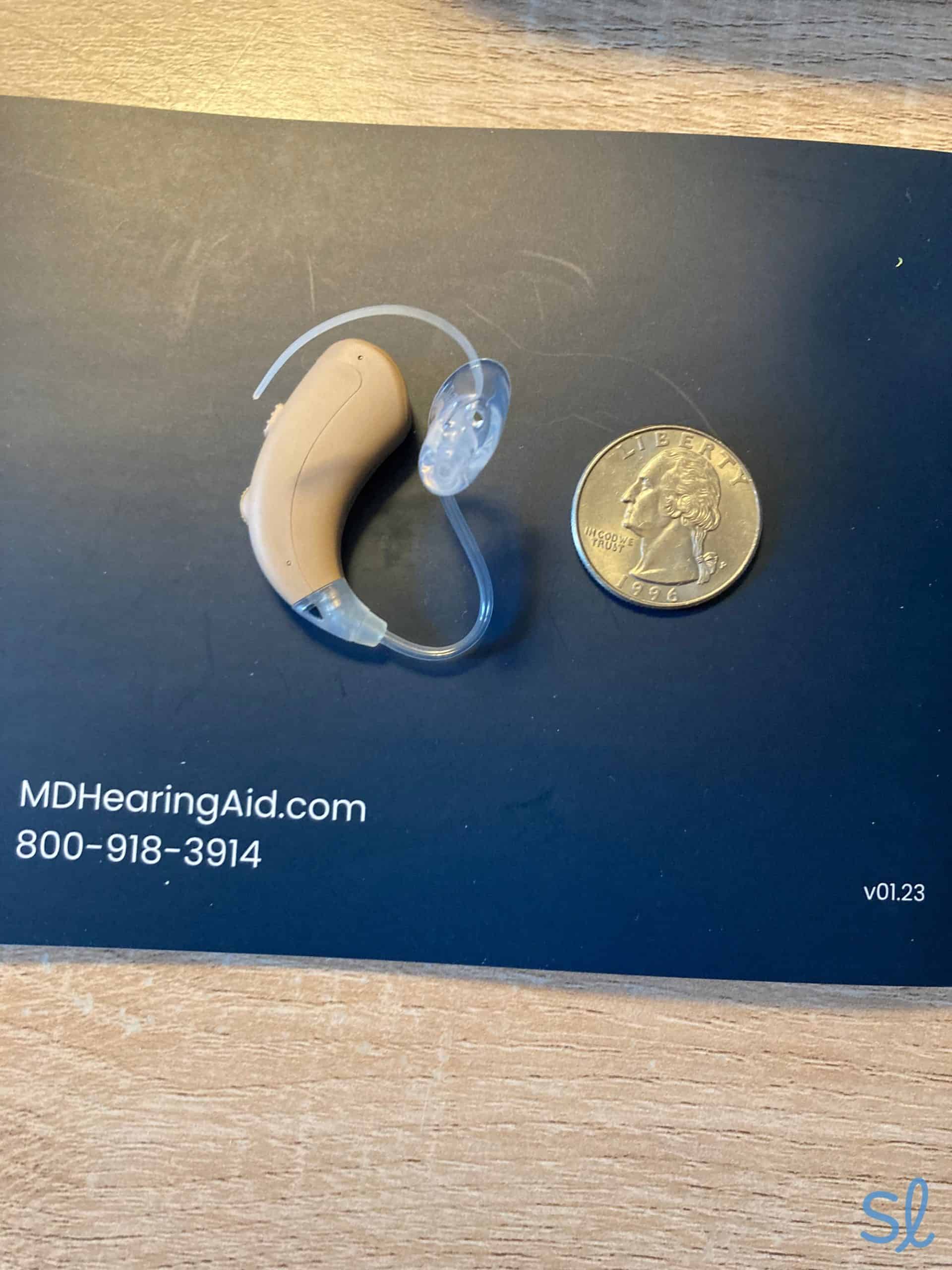
Testing out MDHearing's VOLT devices, which are small and sit behind the ear.
All in all, I found the manual and other written materials to be clear and full of useful information. By reading it, I learned how to troubleshoot sound issues, use the devices with a phone, and order parts and protection.
Setup and Testing VOLT Hearing Aids
Charging VOLT
The manual indicated that VOLT hearing aids took around two hours to fully charge. Three blue indicator lights let you know that the case and the hearing aids are in the process of charging. The lights turn green once the hearing aids are fully charged. According to the manual, a full charge gives you 20 hours of power.
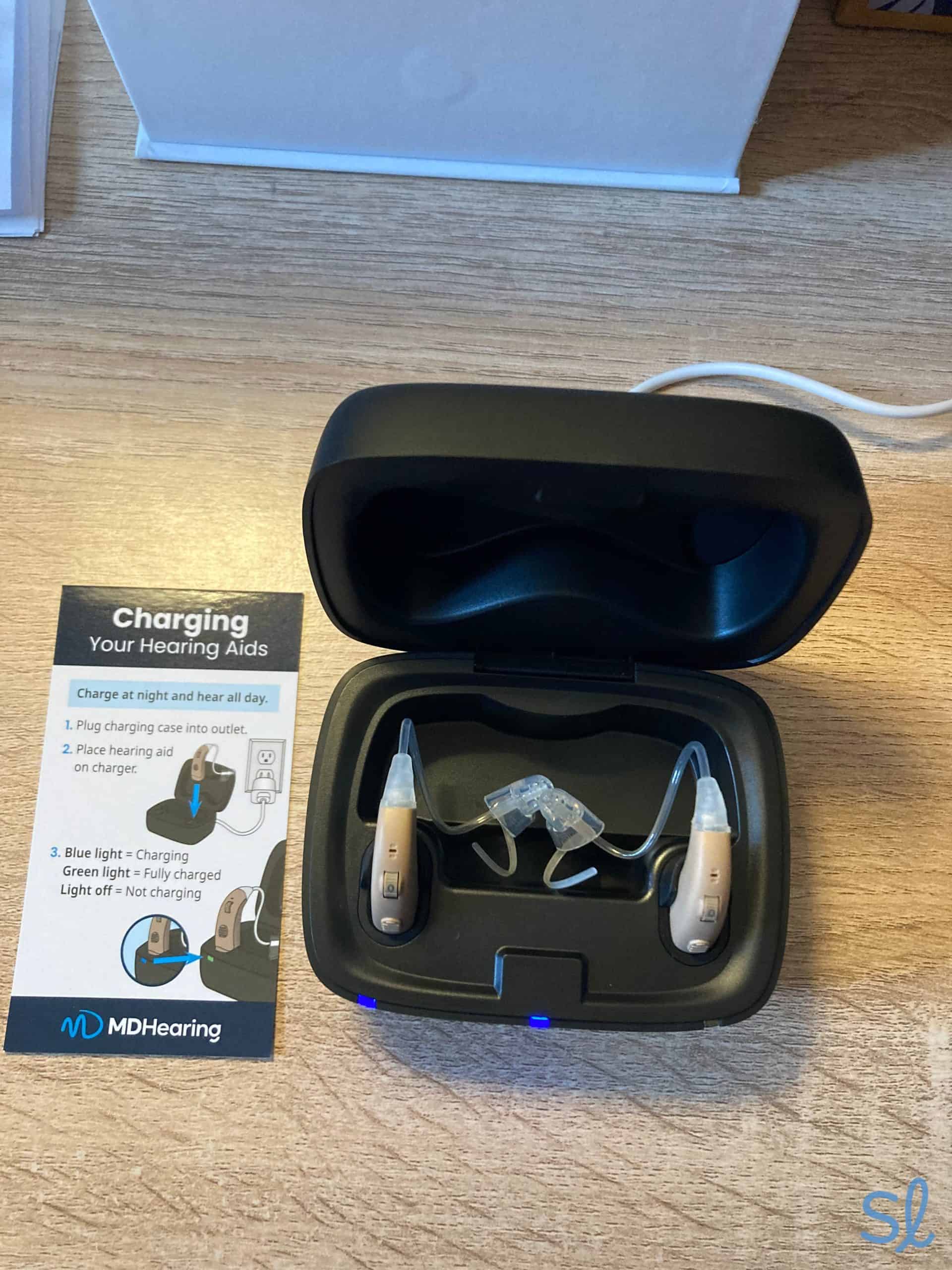
Charging the Volt
My hearing aids charged fully in 1.5 hours. One of the three blue dots remained blue instead of turning green at the 1.5 hour mark. I didn’t know if that meant the hearing aids weren’t charged fully, as this wasn’t explained in the manual. So, I kept the case plugged in for another hour just to be on the safe side, but the lights remained the same — two green and one blue.
When I took the hearing aids out of the charger case, I noticed it was hard to tell the left hearing aid from the right one. The color coding on each hearing aid is translucent and very faint, making it difficult to discern which is which. If you have vision loss, this is something to note.
Placing VOLT In the Ears
MDHearing’s VOLT devices are behind-the-ear (BTE) style. To put them on, I inserted the comfort tip end into my ear canal first. Then I wrapped the hearing aid around my ear so the housing sat behind my ear. The housing contains two microphones, a volume (on/off) dial, and a program button.
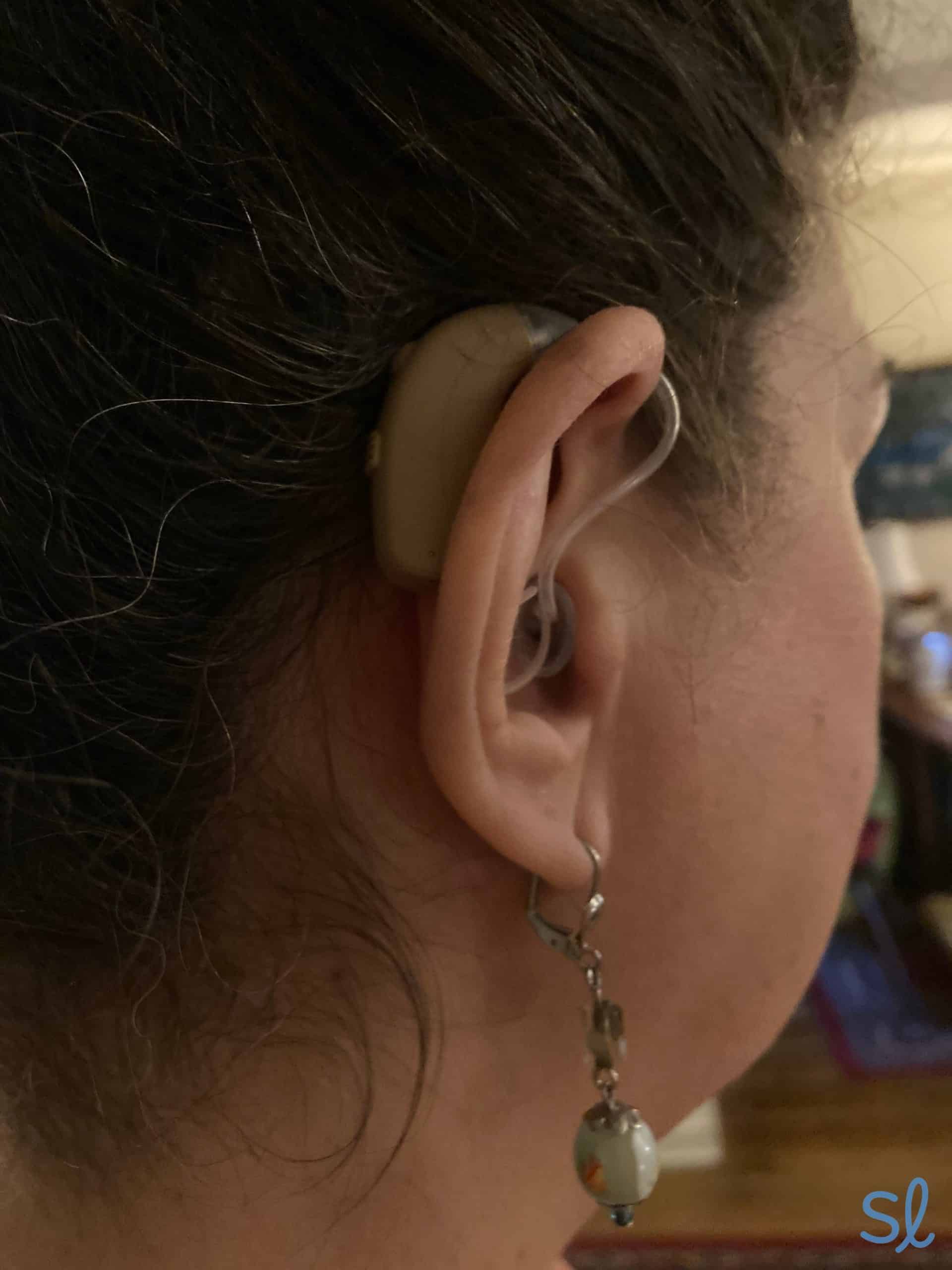
Wearing MDHearing's VOLT devices
The hearing aids were very easy to put in my ears. I found VOLT hearing aids to be discreet. I could now see the benefit of removing the excess tubing (which I hadn’t done yet, as the photo shows), as it would make them stick out less. These hearing aids were very comfortable, even with my glasses on.
Unlike some OTC BTE hearing aid lines, such as the Audicus Wave Series 2, VOLT is only available in one color, a beige tone. If you want something to better match your skin tone, or you’re looking for a fun color, you may want to consider a different brand.
Programming VOLT
VOLT doesn’t connect to a mobile app, which I was disappointed to see. Other hearing aids I’ve tested, including the Jabra Enhance Select 300, have a mobile app for adjusting settings and receiving support. With the VOLT, the settings are solely controlled on the hearing aids themselves.
The volume dial also serves as an on/off dial. Volume levels range from zero to three, with zero indicating your hearing aids are “off.” The volume dial had a learning curve for me; it was really easy to go up in volume by accident. I did this, and it hurt my ear. What worked for me was to set the dial on one or two before insertion. If you want to adjust the volume on the go, when your hearing aids are in, do it slowly until you get the hang of it.
The program button was easy to use while the hearing aids were in my ears. There are four programs to choose between:
- Quiet (one beep): Good for TV watching and one-on-one conversations in quiet places
- Social (two beeps): Good for conversations in small groups
- Noisy (three beeps): Meant for use in large crowds, driving in traffic, listening to high-octave music, and being in nature
- Restaurant (four beeps): Good for honing in on one-on-one conversations in loud places
Using VOLT Hearing Aids
When I first started wearing VOLT, I noticed a feedback sound similar to white noise in each ear. In the right hearing aid, the feedback sound was also accompanied by some mild bumping sounds, in an indeterminate pattern.
This is something that Dr. Ruth Reisman, our resident audiologist, has also experienced while testing MDHearing’s devices. She noted these devices may strongly over amplify for those with mild to moderate hearing loss, an important drawback to consider.
Did You Know? High frequency sounds are usually the first type to go when people have hearing loss.2 High-pitched sounds include children’s voices and birds chirping.
I used the chat feature on MDHearing’s website to ask about that. Jeremy, the chat specialist, said that this was normal and would become less apparent with use, which it did. I didn’t notice the “white noise” sound when I was outside taking a walk or inside on the phone. All in all, I found VOLT’s sound quality to be gentle and natural rather than cutting-edge crisp.
MDHearing VOLT Price
MDHearing’s VOLT costs $397 per pair, making it one of the most affordable OTC hearing aids we’ve reviewed. For comparison, Eargo’s hearing aids start at $799 and range up to $2,950 per pair. It’s also competitively priced compared to prescription BTE hearing aids like Signia’s Pure Charge&Go IX or Phonak’s Naída Marvel, which cost a few thousand dollars per device.
MDHearing manufactures several OTC hearing aids in various styles. Here’s how VOLT stacks up pricewise:
| Hearing aid | Price per pair |
|---|---|
| VOLT | $397 |
| AIR | $297 |
| NEO | $297 |
| NEO XS | $397 |
You can read our comprehensive MDHearing review to learn more about this brand’s complete offerings.
MDHearing VOLT vs. Jabra Enhance Select 300
The Jabra Enhance Select 300 is a mini RIE (receiver-in-ear) hearing aid. It’s designed to be smaller and more compact than the MDHearing VOLT’s BTE style. Despite the differences in size, I found both hearing aids to be very comfortable and discreet.
The Enhance 300 is significantly more expensive than the VOLT at $1,795 for the Basic Package or $1,995 for the Premium Package. The main difference between these hearing aids is the follow-up support. If you buy Jabra Enhance’s Premium package, you get unlimited audiological support for three years. Both the Basic and Premium package also include access to a mobile app you can use to program your hearing aids. The Jabra Enhance Select 300s also connect to devices like a TV streamer and portable microphone that prioritizes speech.
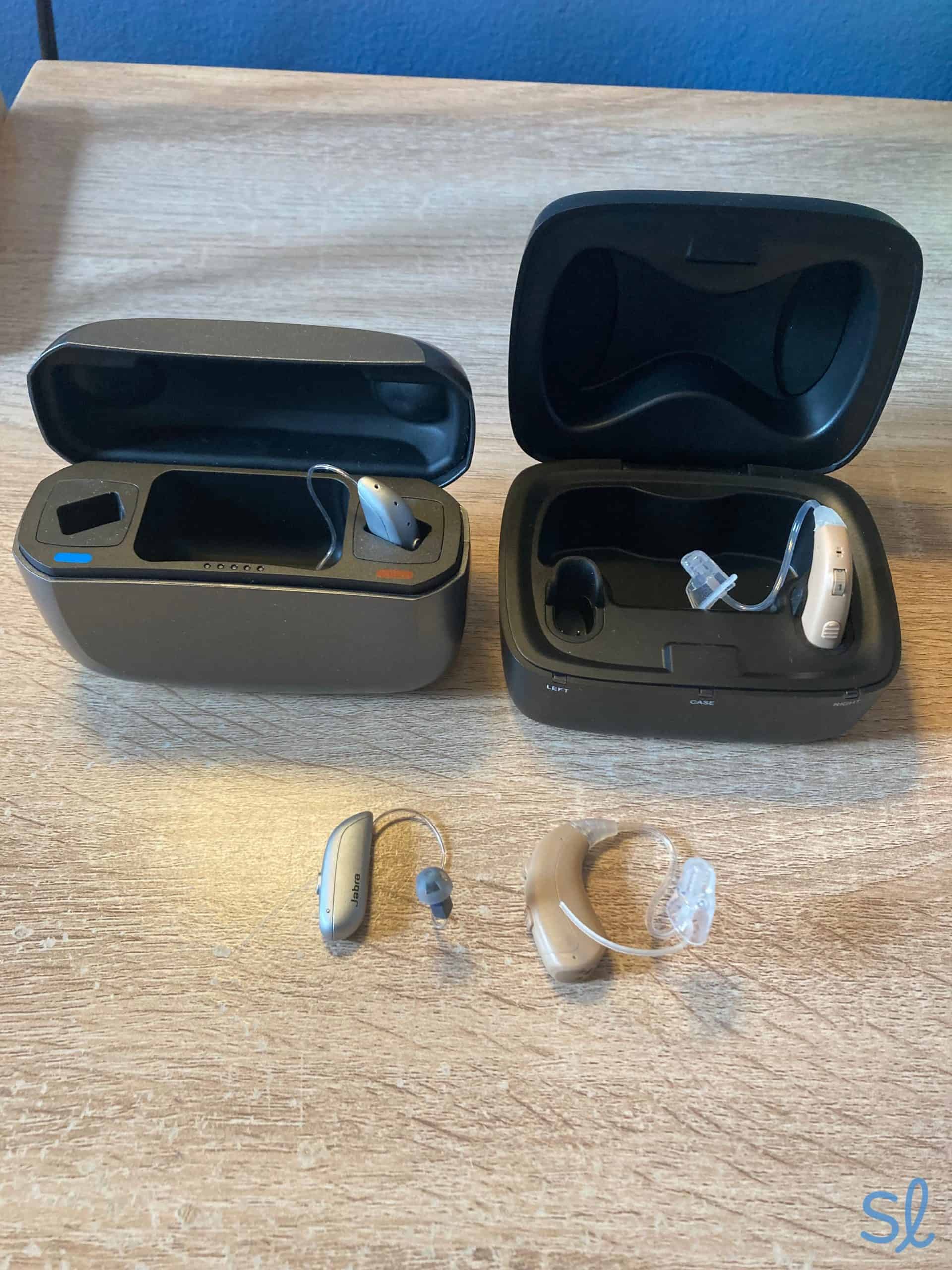
VOLT vs Jabra 300
If you’re on a budget and looking for a no-frills hearing aid, the VOLT may be your best choice. If you want more special features, including hands-free calling, Bluetooth streaming, and audiological support, the Jabra 300 Premium Package is a better choice.
Final Thoughts on MDHearing VOLT
MDHearing’s VOLT is a no-frills, BTE hearing aid that provides good sound quality. These hearing aids are relatively affordable, making them a good choice for people on a budget who have mild to moderate hearing loss. Since these hearing aids don’t connect to a mobile app, they’re also a good choice for people who would prefer not to use advanced technology.
Frequently Asked Questions About MDHearing VOLT
-
Do MDHearing Volt hearing aids have built in tinnitus tools?
These hearing aids don’t come with a sound therapy program specifically designed to reduce tinnitus (ringing in the ears). However, using hearing aids typically improves hearing enough to reduce the annoyance of tinnitus sounds. Check out our picks for the best hearing aids for tinnitus in 2025 to learn more.
-
Do MDHearing VOLT hearing aids use disposable batteries?
VOLT is rechargeable. There is no disposable battery option available for these hearing aids.
-
Can I sync my smartphone to MDHearing VOLT?
These hearing aids don’t have Bluetooth streaming or smartphone compatibility.
-
Can I pay for MDHearing VOLT with my flexible spending account (FSA) or health savings account (HSA account)?
OTC hearing aids are eligible for reimbursement from HSA and FSA plans. To be on the safe side, double-check with your particular plan before you buy.3
NYHD Institute for Hearing & Balance. (2024). Why are High Frequency Sounds Typically The First To Go In Hearing Loss?
MDHearing. (2022). 19 FSA-Eligible Items and Expenses That Will Shock You (Including Hearing Aids!)


